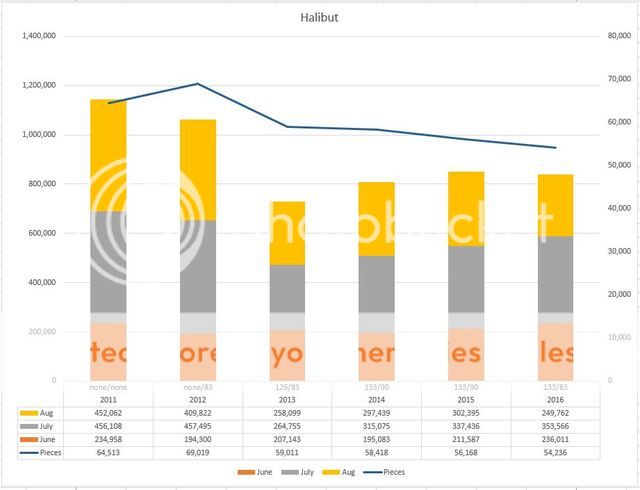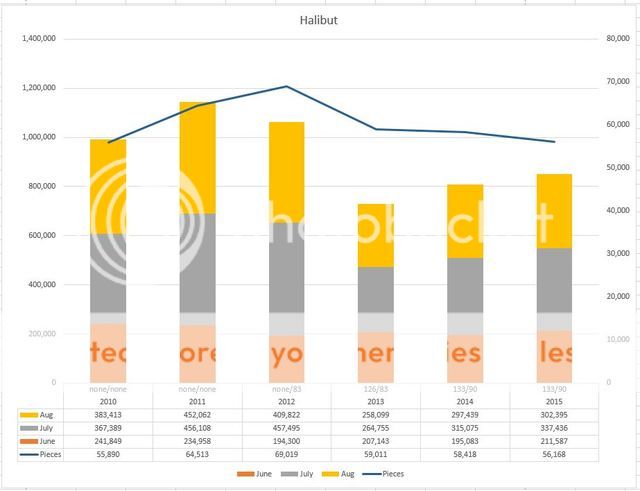Cut Plug
Well-Known Member
Hi:
I do sit on the SFAB halibut working group and have done for over a decade. While I honestly don't have the opportunity to engage in an active debate on this forum, I'll do my best to answer some of the SFAB related questions that have arisen to the best of my ability.
First off, and to clear the air again, those of us that sit on the SFAB have by now become pretty much immune to the ill informed and intentionally confrontational opinions offered by a few on this site regarding the participation, biases, intentions, influence etc, etc of the SFAB process. I've offered my opinion on that subject before so won't waste anyone's time doing it again. What I will offer though, is to be very careful what you wish for. DFO is in an extremely difficult situation right now regarding operating budget and human resources at the fishery management level, so any excuse to cut corners on consultation will be gladly accepted. If you think, however, that what we've got now is likely to be replaced by some kind of internet forum or survey that will need to be read, analyzed, collated and responded to by DFO staff, you're dreaming in technicolor IMO. An SFAB website has been on the table for years now. No action from DFO. What has also been bandied about is replacing meetings with webinars. I guess we'll see how that unfolds. More and more we do utilize conference calls, and for the most part that works well. Being kind of old school, and also one who personally prioritizes fishery management as something I care about deeply, I have no issue making the effort to travel and attend face to face meetings. I simply find them more productive and engaging, and so will continue to lobby for maintenance of the existing system.
So...in no real order here's my shot at issues that have been raised thus far that I have answers for:
Back to storm watching. Sure glad I pulled my boat on Tuesday!
CP
I do sit on the SFAB halibut working group and have done for over a decade. While I honestly don't have the opportunity to engage in an active debate on this forum, I'll do my best to answer some of the SFAB related questions that have arisen to the best of my ability.
First off, and to clear the air again, those of us that sit on the SFAB have by now become pretty much immune to the ill informed and intentionally confrontational opinions offered by a few on this site regarding the participation, biases, intentions, influence etc, etc of the SFAB process. I've offered my opinion on that subject before so won't waste anyone's time doing it again. What I will offer though, is to be very careful what you wish for. DFO is in an extremely difficult situation right now regarding operating budget and human resources at the fishery management level, so any excuse to cut corners on consultation will be gladly accepted. If you think, however, that what we've got now is likely to be replaced by some kind of internet forum or survey that will need to be read, analyzed, collated and responded to by DFO staff, you're dreaming in technicolor IMO. An SFAB website has been on the table for years now. No action from DFO. What has also been bandied about is replacing meetings with webinars. I guess we'll see how that unfolds. More and more we do utilize conference calls, and for the most part that works well. Being kind of old school, and also one who personally prioritizes fishery management as something I care about deeply, I have no issue making the effort to travel and attend face to face meetings. I simply find them more productive and engaging, and so will continue to lobby for maintenance of the existing system.
So...in no real order here's my shot at issues that have been raised thus far that I have answers for:
- Why do we have a coast wide management plan in effect? The main reason is the desire to offer consistent opportunity and expectation to all anglers across the province. The second is that its reasonable to assume that the fleet is pretty mobile. Lots of boats on trailers out there. It is therefore assumed that differential PFMA based regs will not be enforceable as anglers are not limited to regional opportunities. We have a coast wide license. The third reason is that at the IPHC level we are provided TAC as one management unit. FYI the SFAB has thought this through, and well beyond the concept stage. While it sounds attractive at first blush, the devil is always in the details. How would this option actually be implemented in the fishery? Well, first off who'd like to step up to the plate and lead the process whereby we divvy up our TAC on a PFMA by PFMA basis? That is the likely only way you could effectively manage PFMA based regs in a fair manner. I guess then we'd need to create regional halibut licenses that apply in each PFMA. Maybe then you'd need to pick "your" PFMA in which to fish? When your PFMA has used up its TAC, is your PFMA shut down? Would local residents get priority? Would you be able to fish or buy a license in in more than one PFMA? How would you manage that process? LEH Port Hardy halibut tags?...lol...The more we scratch even a little bit beneath the surface of this idea the more unrealistic it becomes. Any ideas on another way to do it other than just assertion that we should do it?
- What is the projected underage for 2016? Based on the information I have, the total estimated catch to the end of the year is 1,012, 844 lbs. That leaves an underage of 88,106 lbs or about 8.7% of the TAC at the end of Dec. In my experience over the past 25 years or so, managing a catch of anything to within 10% or less isn't something to be ashamed of. FYI - a subtle change in weather, average size or availability of other species leading to a shift in effort could have easily put the catch 10% the other side of the TAC. To put it in perspective, we averaged over 88,000 lbs per week in July this year.
- What about the 2nd fish slot? Well, we've been trying to get additional data on this for a few years now to help answer that question. We still don't have it so until we do I guess we'll continue to take the high road and be precautionary by assuming that no size limit on the second fish may drive catch up. Maybe the iREC or iARC internet surveys will be used this year to help get some data. I hope so.
- The iARC survey did inform us that less than 10% of halibut anglers in the province actually catch their six fish annual limit.
- Why don't we use the overage and underage provisions that are used by the commercial sector? The reason for this is that it would imply that we "own" our TAC when in fact we don't. In 2010 and 2011 the lobby groups that did and still do represent the recreational fishery in BC (SFI, BCWF, SVIAC) engaged in some serious and well organized political action that provided an increase of 3% in our TAC. One of the underlying premises of this action, and a position I believe is still strongly supported by the majority of anglers today, is that halibut are a common property resource managed by the federal government on behalf of all Canadians. The supreme court agreed with this notion in 2013 in the Malcolm Case.
Back to storm watching. Sure glad I pulled my boat on Tuesday!
CP
Last edited:



